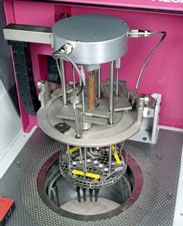
US-based testing tools manufacturer Instron has introduced the Ceast HV500 thermal tester featuring a temperature range from 50-500°C to gauge the Vicat softening temperature (VST, ISO 306) and heat deflection temperature (HDT, ISO 75) of high temperature plastics like LCP, PEI and PEEK.
VST is the temperature at which the surface of a plastic specimen is penetrated to a depth of 1 mm by a defined steel needle at a constant load with steadily increasing temperature. HDT is the temperature at which a specimen supported at both ends deforms by a specified amount under a defined, centrally applied load and at a uniform temperature increase (outer fibre strain equals 0.2%).
Unlike the conventional systems that use silicone oil as a heating medium, which due to its flash point can only be used at temperatures up to 300°C, the HV500 tester provides controlled heat input through a fluid bed. This consists of high heat conductive aluminium oxide powder with a grain size of 20 to 60 microns heated by a flow of hot air, thus enabling measurements to be performed with precision and repeatability, says Instron.

Ring tests conducted at an international level have underlined the quality of test results and demonstrated the suitability of the new method for practical use in industrial quality assurance as well as in research and development.
Benefits of the Ceast HV500 thermal tester include operator safety in the test laboratory since it does not use a flammable heat transfer medium. Also, the aluminium oxide powder in the tester allows shorter cycle times then conventional oil baths, as the fluid bed takes less time to cool down, and specimens will be free from oily residues after the test. Particles adhering to the surface can be removed easily and testing-related contamination of hands, clothing, and laboratory equipment are avoided. Noxious vapours from evaporating oil are also prevented. There is no degradation of the aluminium oxide particles allowing the system to work without requiring oil-related changing intervals and associated procurement, storage and labour cost.
Furthermore, Instron says the tester enables simultaneous testing of three specimens in three independent testing stations. HDT and Vicat tests can be performed in parallel. A pneumatic system automatically lowers all three testing stations at the beginning of a test and raises them at the end of the test. Likewise, an automatic pneumatic system applies and removes the test weights. During the test, the protective cover remains closed until the bath temperature has fallen below a preset threshold.
The system can be used as a stand-alone unit, controlled by a microprocessor or touch pad. The instrument can also be connected directly to a PC running the Instron VisualTHERM software for parameter management, process control as well as storage and evaluation of measurement data. VisualTHERM provides all test results specified in the relevant interna¬tional standards for thermo-mechanical HDT and Vicat tests, both in numerical and graphical form.
(PRA)














